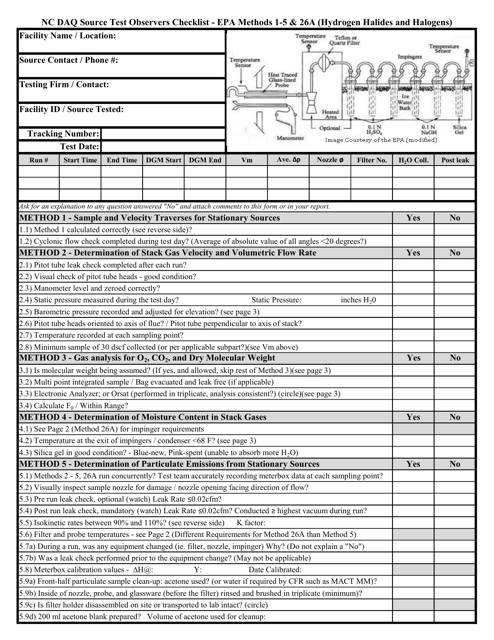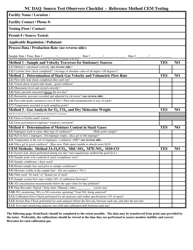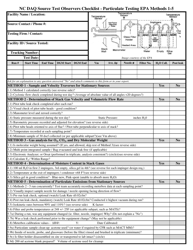Source Test Observers Checklist - EPA Methods 1-5 & 26a (Hydrogen Halides and Halogens) - North Carolina
Source Test Observers Checklist - EPA Methods 1-5 & 26a (Hydrogen Halides and Halogens) is a legal document that was released by the North Carolina Department of Environmental Quality - a government authority operating within North Carolina.
FAQ
Q: What is the purpose of the Source Test Observers Checklist?
A: The purpose of the checklist is to assist in conducting source testing for hydrogen halides and halogens.
Q: Which EPA methods does the checklist cover?
A: The checklist covers EPA Methods 1-5 & 26a, which are used for measuring hydrogen halides and halogens.
Q: Why is measuring hydrogen halides and halogens important?
A: Measuring hydrogen halides and halogens is important for assessing air quality and compliance with environmental regulations.
Q: Who can use the Source Test Observers Checklist?
A: The checklist can be used by source test observers, such as technicians and engineers, who are conducting testing for hydrogen halides and halogens.
Q: What is the purpose of EPA Methods 1-5 & 26a?
A: EPA Methods 1-5 & 26a provide standardized procedures for sampling and analysis of hydrogen halides and halogens in emissions from industrial sources.
Q: Why is it important to follow the checklist?
A: Following the checklist ensures that source testing for hydrogen halides and halogens is conducted in a consistent and accurate manner.
Q: Are there any specific requirements for using the checklist?
A: Yes, users of the checklist must be familiar with EPA Methods 1-5 & 26a and have appropriate training and qualifications for conducting source testing.
Q: Can the checklist be customized for specific testing needs?
A: Yes, the checklist can be customized to include additional items or procedures that are specific to the testing requirements of a particular facility or project.
Q: What are some common items included in the checklist?
A: Common items in the checklist include equipment checks, calibration procedures, sampling protocols, and data recording and documentation.
Form Details:
- The latest edition currently provided by the North Carolina Department of Environmental Quality;
- Ready to use and print;
- Easy to customize;
- Compatible with most PDF-viewing applications;
- Fill out the form in our online filing application.
Download a printable version of the form by clicking the link below or browse more documents and templates provided by the North Carolina Department of Environmental Quality.









